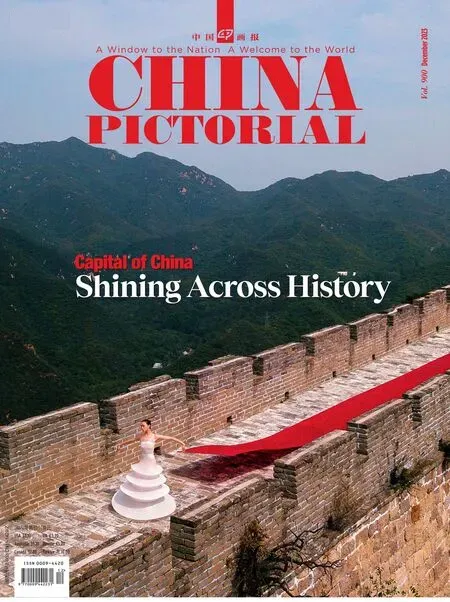Rediscovering Beijing’s Historical and Cultural Significance
Text by Wang Jun

The author is director of the Palace Museum Research Institute.
Beijing’s rich historical and cultural resources hold immense practical significance and offer valuable insights for the sustainable and peaceful development of both Beijing and its surrounding regions as well as China as a whole.
Many renowned scholars from both China and abroad have talked about the historical and cultural significance of Beijing as a city.Among them are Liang Sicheng(1901-1972),a prominent Chinese architect,and Edmund N.Bacon (1910-2005),a renowned American urban designer.When expressing their high regard for the historical,artistic,and scientific value of Beijing,they consistently highlighted the profound connection between ancient urban spaces in Beijing and the natural environment.This provides a crucial direction for further studies of the historical and cultural value of Beijing.
The Eastern urban construction model epitomized by Beijing,grounded in the natural environment and conceived as an integrated whole,traces its origins to the inherent cosmology of Chinese ancestors and is intricately connected to ancient Chinese agricultural civilization.The dawn of agricultural civilization signified not only the domestication of crops and animals but also the precise mastery of time.In contrast to Europeans,who determined time by observing the sun’s movement among the twenty-eight constellations,the ancient Chinese relied on monitoring celestial bodies’positions on the horizon.In this observational system,the gnomon and the circular shape based on it form the Chinese characterzhong(中),exerting a decisive influence on the layout of Chinese architecture and even entire cities,characterized by central axis symmetry.
The central axis of Beijing during the Ming (1368-1644)and Qing (1644-1911) dynasties exemplifies a governance centered around the three main halls.The space and layout implied by this arrangement reflects the ancient astronomical observation system,foundational knowledge that China’s ancestors needed to master for the establishment of an agricultural civilization.As an exceptional representative and magnificent model of the Chinesezhongshaped city layout,the idea of managing the old urban spaces in Beijing can be traced directly back to the origins of Chinese civilization.When assessing the historical and cultural value of Beijing,this aspect demands profound consideration.
Situated in the environs of the Bohai Sea,Beijing served as a crossroads for the amalgamation of agrarian,northern nomadic,and fishing-hunting cultures.There,diverse cultures collided and blended,giving rise to early Chinese civilization.This dynamic accompanied the establishment of the Xia(around 2100-1600 B.C.),Shang(1600-1046 B.C.),and Zhou (1046-256 B.C.) dynasties as well as the Qin (221-207 B.C.) and Han(202 B.C.-220 A.D.) empires,and it also propelled the profound transformation of ancient Chinese culture and civilization towards a state of “unity in diversity.”

An aerial view of the Bell Tower and Drum Tower along the Beijing Central Axis,October 2013.The Bell Tower and Drum Tower were built during the Yuan Dynasty (1271-1368) and hold rich urban memories of Beijing.(Photo by Ma Wenxiao)

To celebrate the Spring Festival,a performance of sacrificial rite for heaven heralds the beginning of the the Temple of Heaven Spring Festival Cultural Week,February 19,2015.(Photo from China News Service)
In his workNew Exploration of the Origin of Chinese Civilization,esteemed modern Chinese archaeologist Su Bingqi(1909-1997) pointed out that the northern region around the Yanshan Mountains-Great Wall line constitutes one of the six major archaeological cultural zones in China.The reasons for a unified multi-ethnic nation seem most concentrated in this area,not only before the Qin Dynasty but also during subsequent periods from the Northern and Southern Dynasties (420-589) to the Liao(907-1125),Jin (1115-1234),Yuan(1271-1368),Ming,and Qing.Many significant historical events unfolded in this area.
Su Bingqi’s reference to significant events consistently revolves around the interplay of agrarian,northern nomadic,and fishing-hunting cultures.Beijing serves as the central stage for these historical “dramas,” with the main theme being “inheritance,absorption,integration,and innovation.” Inclusivity is a hallmark of Chinese culture.The ancient architecture and urban remnants of old Beijing provide valuable testimony to the continuous and extensive development of this grand history.Archaeological research on Beijing’s urban areas from the Yuan,Ming,and Qing dynasties has achieved considerable success in recent years.Unfortunately,systematic and scientific archaeological work has yet to extend further into Beijing’s more distant history.Consequently,our understanding of the conditions of Beijing’s city site before the Yuan Dynasty,and even more so before the Jin Dynasty,remains largely in the realms of document studies and speculation.
Beijing’s rich historical and cultural resources hold immense practical significance and offer valuable insights for the sustainable and peaceful development of both Beijing and its surrounding regions as well as China as a whole.The conceptual foundations embedded in the spatial design of Beijing’s old city,rooted in reverence for nature,beliefs inspired by celestial phenomena,and adherence to geographical principles,represent the tangible manifestation of ancient Chinese philosophy,particularly the concept of“harmony between man and nature.” This holds considerable practical relevance in coping with crises such as environmental degradation from the adoption of growth-oriented production and lifestyles after the Industrial Revolution.The historical architecture and urban spaces in Beijing serve as witnesses to the transition towards a unified diversity of culture and showcase the openness and adaptability inherent in Chinese culture.This aspect carries immense enlightening significance for the cause of peace and development of humanity in today’s world.

